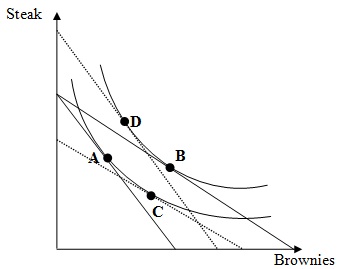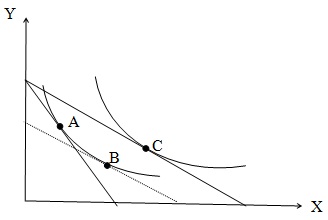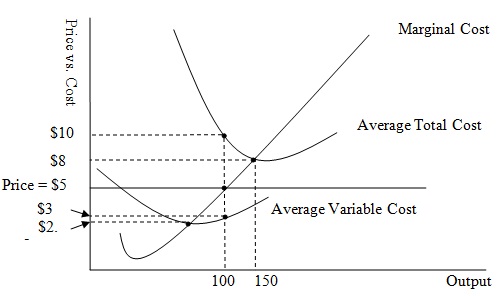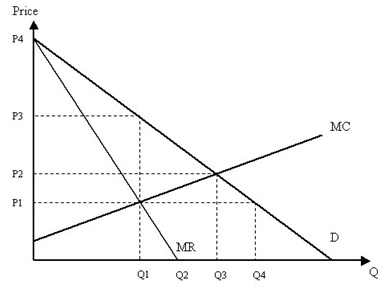I. Binary Choice Questions
Question 1. Suppose as the price of good X increases and we move along the demand curve from point C to point D, total revenue also increases. Which of the following statements must be false?
a. Points C and D are both in the elastic region of the demand curve.
b. Points C and D are both in the inelastic region of the demand curve.
Question 2. In a small open economy, when the government imposes barriers to international trade (tariffs and/or quotas) the economic surplus of __________ increases when compared to this group’s economic surplus with free trade and no government intervention in the market.
a. Domestic consumers
b. Domestic producers
Question 3. Which of the following statements is true for a small open economy?
a. A quota is effective if the amount of the quota is greater than the number of units of the good imported when there is no quota.
b. A tariff is effective if the domestic price is higher than the world price and the imposed tariff is less than the difference between the domestic price and the world price.
Question 4. "If nominal prices increase due to inflation, it is possible for real prices to remain the same". This statement is
a. True
b. False
Question 5. Coke and Pepsi are perfect substitutes. If the price of Coke increases, then
a. The substitution effect is 0, and the change in demand is completely due to the income effect.
b. The income effect is 0, and the change in demand is completely due to the substitution effect.
Question 6. Alex spends all his money on apples and raspberries. The price of apples and raspberries falls by 50%. At the same time, Alex’s income falls by 50% of its original value. As a result, Alex’s budget constraint
a. Shifts inward toward the origin.
b. Remains unchanged.
Question 7. A firm is producing at an output level such that the firm’s average cost is less than its marginal cost. If this firm produces one additional unit of output, how will its average cost change?
a. The firm’s average cost will increase.
b. The firm’s average cost will decrease.
Question 8. Which of the following statements is true?
a. A period of 10 years is sufficiently long enough that every firm can always consider this length of time the long run.
b. A period of 10 years can be considered the short run for a firm if some of the inputs the firm uses are not variable for that firm within that period of ten years.
Question 9. Suppose that labor is the only input used in producing car wash services. 1 unit of labor can wash 1 car per hour, while 2 units of labor can wash 3 cars per hour. From 1 unit of labor to 2 units of labor, the technology at the car wash displays
a. Increasing returns to scale.
b. Constant returns to scale.
Question 10. The soccer ball market in Brazil is perfectly competitive. Currently the price of a soccer ball is $25 and all firms in the soccer ball market in Brazil are producing at their profit maximizing level of output. We observe one firm producing 2,500 soccer balls per day. What can we say about the firms in this market?
a. All firms face a marginal cost of $25 at their current level of output.
b. All firms must be producing 2,500 soccer balls per day.
Question 11. A natural monopoly exists in an industry in which production is characterized by _________ over the range of output that is relevant for the industry.
a. Economies of scale
b. Increasing marginal revenue
Question 12. It is possible for a natural monopoly to provide a good or service more efficiently than many small, perfectly competitive firms serving the same industry.
a. True
b. False
II. Multiple Choice Questions
Use the following information to answer the next two (2) questions.
The price of good Y decreased from $ 7 to $5. Meanwhile, the sales of good X increased from 10 units to 14 units.
Question 13. Cross-price elasticity of demand of goods X and Y, calculated using the midpoint method (this is the same as the arc elasticity method), is:
a. 1
b. 0
c. –1
d. We need more information to determine the cross-price elasticity between the two goods.
Question 14. Goods X and Y are:
a. Substitutes
b. Complements
c. Unrelated
d. We need more information to determine the relationship between the two goods.
Question 15. The demand for Mac n’ Cheese is given by QD = 36 – 3P. At P = $9 the demand curve is:
a. Elastic
b. Inelastic
c. Unitary
d. Perfectly elastic
Use the following information to answer the next two (2) questions.
Neverland is a small, closed economy. In Neverland the domestic market for chocolate bars is given by the following equations:
Domestic Demand: P = 61 - QD
Domestic Supply: P = 1 + (1/5)Qs
The world price of chocolate bars is $6 per unit.
Question 16. If Neverland’s government opens their economy and allows free trade of chocolate bars, how many units will Neverland import or export? Neverland will
a. Export 20 units.
b. Export 30 units.
c. Import 20 units.
d. Import 30 units.
Question 17. Suppose Neverland has opened its economy to trade. To protect domestic producers, Neverland’s government decides to charge a $3 tariff on every imported chocolate bar. What is the total revenue raised by this tariff?
a. $36
b. $45
c. $90
d. $150
Use the following information to answer the next two (2) questions.
The nation of Azkaban is a small open economy. In Azkaban, the domestic market for handcuffs is given by the following equations:
Domestic Demand: QD = -(1/2)P + 29
Domestic Supply: Qs = 3P - 6
The world price of handcuffs is $6 per pair. Assume quantity is measured as pairs of handcuffs.
Question 18. Azkaban’s government decides to help domestic producers by imposing a quota of 7 pairs of handcuffs. What is the total quota license holder revenue under this policy?
a. $0. No handcuffs are imported.
b. $7
c. $14
d. $56
Question 19. What is the quantity of handcuffs supplied by domestic producers under the quota policy described in the previous question?
a. 12 pairs of handcuffs
b. 18 pairs of handcuffs
c. 24 pairs of handcuffs
d. 25 pairs of handcuffs
Use the following information to answer the next two (2) questions.
Assume that, using 2000 as your base year, you find that the CPI in 2000 is 100, and the CPI in 2008 is 150.
Question 20. The nominal price of ice cream was $3 in 2000. What was the real price of ice cream in 2000 using 2008 as a base year?
a. $3.00
b. $1.50
c. $4.50
d. $2
Question 21. Suppose your nominal annual wage was $60,000 in 2000, and you are making a nominal wage of $90,000 in 2008. Considering the value of the CPIs provided in the above information, what can you say about your purchasing power in 2008 relative to you purchasing power in 2000? My purchasing power in 2008 is
a. Increasing relative to my purchasing power in 2000.
b. Decreasing relative to my purchasing power in 2000.
c. Unchanged relative to my purchasing power in 2000.
d. Impossible to determine given the information that is available.
Question 22. Bucky has $330 to spend between football tickets and basketball tickets. Football tickets are $45 and basketball tickets are $15. He wants to buy 4 football tickets and 10 basketball tickets. After buying these goods, his marginal utility of attending another football game would be 5 utils, and his marginal utility of attending another basketball game would be 2 utils. If you were Bucky’s friend, you would suggest to Bucky that he should
a. Spend his money as he is planning to, since he will maximize his utility given his budget constraint when he selects this consumption bundle.
b. Spend more money on basketball tickets and less on football tickets in order to maximize his utility given his budget constraint.
c. Spend more money on football tickets and less on basketball tickets in order to maximize his utility given his budget constraint.
d. Attend more football games and more basketball games in order to maximize his utility given his budget constraint.
Use the following information to answer the next two (2) questions.
Jane likes to eat steak and brownies for lunch. Each day, she has a fixed budget for lunch. The graph below illustrates Jane’s daily utility maximization problem.

Question 23. Assume the price of brownies decreases from its original level and as a result Jane’s consumption changes from A to B. The income effect is represented by
a. A movement from A to C.
b. A movement from A to D.
c. A movement from C to B.
d. A movement from D to B.
Question 24. After some time passes suppose that the price of brownies increases back to its original level. Instead of consuming at point B Jane changes her consumption to point A due to this price increase. The substitution effect of this second price change (the increase in the price of brownies) is represented by
a. A movement from B to D.
b. A movement from B to C.
c. A movement from D to A.
d. A movement from C to A.
Question 25. Will spends his income on food and cigarettes. Assume that Will’s indifference curves with respect to these two goods are normally shaped (i.e. Will’s indifference curves are downward sloping and convex shaped). In order to discourage smoking, the government imposes a tax on tobacco, which leads to an increase in the price of cigarettes. At the same time, to encourage overall consumption, the government lowers the income tax. Assume the resulting increase in Will’s income is just enough to place him on the same indifference curve as he was before the tax reform. What is the effect of these taxes on Will’s demand for cigarettes?
a. Will smokes more cigarettes than he did before the tax reform.
b. Will smokes fewer cigarettes than he did before the tax reform.
c. Will’s demand for cigarettes is unaffected by the tax reform.
d. It is not possible to determine the effect of the tax reform on Will’s demand for cigarettes from the given information.
Question 26. According to the following graph, which statement is true?

a. Both goods in the above graph are normal goods.
b. Both goods in the above graph are inferior goods.
c. Only good X is a normal good in the above graph.
d. Only good Y is a normal good in the above graph.
Question 27. Which of the following statements is true?
a. Accounting profits are widely used in business, because accounting profits are more rigorously calculated than economic profits.
b. Accounting profits are usually smaller than economic profits.
c. Economic profits take into account fixed costs whereas accounting profits do not.
d. Accounting profits take into account only explicit costs whereas economic profits also consider implicit opportunity costs
Question 28. Suppose that one firm uses labor and capital to produce a good. It hires 20 employees and pays them a constant wage rate. Assume that the employment contract has a very long term, so that the firm can’t fire any employees without going through a very long legal process. Also, the firm doesn’t hire any new employees under any circumstances. In the short run, how would this firm categorize its labor costs? Its labor costs are
a. A variable cost.
b. A fixed cost.
c. A marginal cost.
d. An average cost.
Use the following information to answer the next three (3) questions.

The graph below shows the cost curves of a representative firm in a perfectly competitive industry. Assume the industry is a constant cost industry and that the equilibrium price in the industry in the short-run is $5.
Question 29. Given that the short-run equilibrium price is $5, which of the following statements is true?
a. This firm is making a positive economic profit.
b. This firm is producing at its break-even point.
c. This firm is making a negative economic profit, and hence it should shut down the production of this good immediately.
d. This firm is making a negative economic profit but should not shut down the production of this good in the short run.
Question 30. Given that all firms are identical in this perfectly competitive industry, what will be the equilibrium price in the long run?
a. $5
b. $8
c. $2.5
d. $10
Question 31. What is the variable cost when this firm produces an output level of 150?
a. $1200
b. $300
c. $500
d. There is not enough information on the graph to calculate the variable cost.
Use the following information to answer the next three (3) questions.
Citizens in Coldsville are only allowed to use snow shovels produced in Coldsville. Firms which produce shovels in Coldsville are not allowed to sell shovels except in Coldsville. Within Coldsville the market for snow shovels is perfectly competitive. Demand for shovels is given by: QD = 1,000 – P. The equation for market supply is: QS = 9P. Each firm in this market has MC = q.
Question 32. How many shovels are sold in Coldsville?
a. 990 shovels
b. 330 shovels
c. 900 shovels
d. 300 shovels
Question 33. How much does it cost to buy a shovel in Coldsville?
a. $90
b. $100
c. $30
d. $300
Question 34. How many firms supply shovels in Coldsville?
a. 9 firms
b. 18 firms
c. 99 firms
d. 900 firms
Question 35. The marginal cost curve for a monopolist is given by the equation MC = 6 + 3Q. The demand for the product in this market is given by the equation QD =26 – P. Given this information, what quantity would a profit-maximizing monopolist produce and what price would this monopolist charge?
a. Q = 2, P = $24
b. Q = 4, P = $18
c. Q = 5, P = $21
d. Q = 4, P = $22
Use the following information to answer the next two (2) questions.
A monopolist’s MC and MR are shown below along with the market demand curve for this product.

Question 36. What quantity does a profit-maximizing monopolist produce?
a. Q1
b. Q2
c. Q3
d. Q4
Question 37. Suppose the government required this producer to produce a level of output equal to Q3. A lobbying firm promises this single producer of the above good that they can get the government to change the output requirement to the profit-maximizing level of output for a monopolist. Which area below represents the maximum amount the monopolist would be willing to pay to hire the lobbying firm?
(Hint: for this problem you will want to compare how the monopolist fares as an unregulated monopolist versus how the monopolist fares as a regulated monopolist.)
a. (P2 - P1)Q1
b. P3 x Q1
c. (P3 - P2)Q1 - (1/2)(P2 - P1) (Q3 - Q1)
d. (1/2) (p3 - P2) + (P3 - P2)Q1